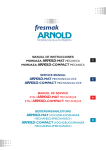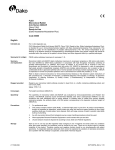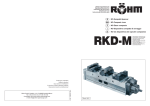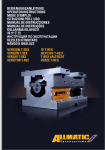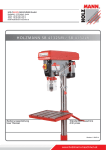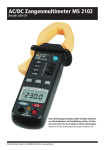Download MORDAZA mat NEUMO HIDRÁULICA mat
Transcript
MANUAL DE INSTRUCCIONES MORDAZA mat NEUMO HIDRÁULICA C SERVICE MANUAL mat PNEUMO HYDRAULIC VICE E MANUEL DE SERVICE ETAU mat PNEUMO HYDRAULIQUE F BEDIENUNGSANLEITUNG mat MASCHINENSCHAUBSTOCK PNEUMATISCH HYDRAULISCH D MANUALE D’INSTRUZIONI MORSA mat PNEUMOIDRAULICA I MANUAL DE SERVICIO w Esta mordaza ha sido sometida a verificaciones de calidad, seguridad y funcionamiento. No obstante, debido a un manejo erróneo o al mal uso, pueden producirse situaciones de lesiones para el trabajador o para terceras personas u otras instalaciones u objetos. w Toda persona que intervenga en el desembalaje, puesta en marcha, manejo, mantenimiento o reparaciones de esta mordaza, esta obligada a leer el presente manual de servicio. w El operario tiene que ser mayor de 18 años, haberle sido enseñado el manejo de la mordaza, haber demostrado su capacitación para el manejo de la misma, haber leido y entendido el presente manual de servicio y observar en todo momento las indicaciones del mismo. Normas de seguridad.w Protección para el personal: w Zapatos de seguridad. w Guantes protectores. w Protección para la cara. w Puesto de trabajo: w Sujetar bien la mordaza a la mesa para evitar que esta se mueva. w Mantener el lugar de trabajo limpio y ordenado. w Desplazamientos: w No situarse nunca debajo de la mordaza mientras se manipula esta con la grua. Desembalaje.w Para proceder a desembalar la mordaza, se debe manipular esta con una grua y un imán, que debe ser adherido a la parte superior de la mordaza intentando buscar un buen reparto de los pesos. w La base de la mordaza, así como el resto de la misma se hallan envueltas en un papel aceitado especial para su mejor mantenimiento. Proceder a separar el papel y acto seguido apoyar la base de la mordaza sobre la mesa de la máquina. Limpieza y mantenimiento.w Para asegurar una duración y condiciones óptimas de la mordaza, debe mantenerse siempre limpia de virutas u otros restos que puedan afectar a su perfecto funcionamiento. w Aire a presión puede ser suficiente para limpiar la mordaza, aunque recomendamos en caso necesario el uso de algún trapo. Atención: No utilizar productos químicos que puedan ocasionar daños a la mordaza. 2 INSTRUCCIONES GENERALES DE LA Mordaza mat Neumo Hidráulica PRESENTACION La mordaza se envía preparada para trabajar, embalada en una caja de madera. Esta caja está pensada fundamentalmente para ser usada como estuche de almacenamiento mientras la mordaza está en desuso. La mordaza se suministra con los siguientes accesorios standard : - Juego de 4 bridas de amarre. - Juego de chapas de protección. - Juego de válvulas para comandar la mordaza. A. FUNCIONAMIENTO Esta mordaza está especialmente diseñada para series largas, que requieran un continuo movimiento automático de amarre y desamarre. Para ello, está ideada con un accionamiento neumático que aprovechando la energía del aire comprimido realiza las operaciones de aproximación automática a la pieza y alta presión de amarre. La mordaza funciona alimentada con aire a 6 bar. de presión. El aire comprimido antes de entrar en el husillo de la mordaza debe ser lubrificado y debe entrar libre de agua (deshumedecido). La mordaza no lleva manilla. Para hacer avanzar el carro de la mordaza debe girarse el cilindro hidráulico con la mano, en sentido horario. Debemos llevar el carro móvil hasta la posición de trabajo, que es la equivalente a la longitud de la pieza a amarrar más 4 mm. Una vez el carro móvil esté situado en ésta posición, mediante el simple movimiento de la válvula manual, el aire realizará las dos funciones antes citadas (recorrido automático y alta presión). Una vez terminado el trabajo, con otro movimiento simple manual, debemos dejar escapar el aire y la mordaza liberará la pieza de la alta presión y realizará un recorrido automático inverso, que nos permitirá colocar una nueva pieza. El husillo de la mordaza está constituido por dos partes bien diferenciadas: En la parte del operario está el cilindro neumático con su válvula de mando y dentro del cuerpo de la mordaza está situado el conjunto multiplicador hidráulico. La unidad hidráulica lleva consigo el husillo principal de la mordaza. B. MANTENIMIENTO/LIMPIEZA Es fundamental, para un buen funcionamiento, que la mordaza esté limpia interiormente. Para evitar la entrada de virutas, se envían las chapas de protección. Para una limpieza completa debemos desmontar el carro móvil. Para ello tenemos que desatornillar el tornillo que lleve el carro en su parte trasera. Ahora, levantando hacía delante, se libera. Hay que tener sumo cuidado para no perder la semi-bola que va colocada en la parte interior del carro. Soltando ahora los 2 tornillos de la brida posterior y los 2 tornillos de la cabeza de la mordaza, liberamos el husillo, que sale hacía atrás con la tuerca. 3 Ahora tenemos la mordaza libre para su limpieza. Un buen mantenimiento nos obliga a utilizar buenas substancias refrigerantes y antioxidantes. El husillo de alta presión, no necesita rellenado periódico de aceite. C. INSTRUCCIONES PARA DESMONTAR EL HUSILLO DE LA MORDAZA 1. Desmontaremos el carro, tal como se explica en el punto (B) de limpieza. 2. Soltamos los 2 tornillos de la brida y los dos pasadores (2004) que lleva la mordaza en la cabeza. Ahora, sacamos todo el conjunto “husillo – tuerca de fundido” fuera de la mordaza. 3. Tal como hemos expresado anteriormente, ahora debemos separar la unidad hidráulica (husillo principal) de la unidad neumática. Para ello, el husillo principal tiene unas partes planas en la unión de ambas unidades. Debemos quitar el tornillo (004) –en el tipo 090 es el (014)- y ahora sujetando el husillo principal, desenroscar la unidad neumática. La brida sale por sí sola del husillo. Ahora se libera la tuerca, pero hay que tener mucho cuidado con el fleje espiral procurando que al quitar la tuerca no se abra totalmente. Ahora ya está totalmente desmontado. D. RELLENADO DE ACEITE 1. Debemos seguir los puntos que figuran en el apartado “C”, hasta tener la unidad hidráulica libre. (Aparece como desmontaje unidad hidráulica). 2. Soltar el prisionero (215) y desenroscar la tapa tirador (1606) de la camisa del depósito (1601) (no perder el muelle (1605) ni la arandela (1621). 3. Colocar el retén (1622) en la camisa depósito (con los labios hacía el fondo) y el (1623) en el alojamiento formado por las piezas (1602 y 1603) (también con los labios hacía el fondo). 4. Introducir el depósito fijo (1602) y la guía retén (1603) (roscadas entre sí, formando una sola pieza) en la camisa depósito (1601), haciendo coincidir los agujeros de ambas piezas. 5. Colocando los pasadores (2004) en sus alojamientos y por medio de aire a presión se consigue que el retén (1622) – en el tipo 090 es el (009)- adopte su posición correcta. 6. Con ayuda de los pasadores (2004) empujar las piezas (1602) y (1603) hasta el fondo de la (1601). 7. Rellenar de aceite el agujero central de la pieza (1603) hasta el borde. Procurar que el aceite no lleve aire o en su caso purgar con un alambre. 8. Colocar el retén (1633) – en el tipo 090 es el (4006)- en el pistón primario (1607) e introducirlo en la guía (1603) sin sacar los pasadores. 9. Ahora colocar el muelle (1605), la arandela (1621) y el husillo principal (1608) y roscar la tapa tirador (1606). Esta tapa se rosca con una llave uña (DIN 1804) hasta hacer tope; colocar el tornillo prisionero (215) – en el tipo 090 no existe-. E. COMPROBACION FINAL Para comprobar que el rellenado de aceite es correcto, antes de colocar el husillo en la mordaza hacer la comprobación siguiente: 1. Montar el cilindro neumático en el extremo del husillo principal (1608). 2. Sujetamos el conjunto en horizontal, por el husillo principal (1608) y colocamos un pasador (2004) en el agujero del depósito fijo (1602). 3. Introduciendo aire en el cilindro neumático, debe apreciarse a simple vista funcionamiento es correcto. 4 que el SERVICE MANUAL w This mat precision machine vice is guaranteed for quality, and workmanship. It has been prepared for its correct operation through our established final assembly and test procedures. Care should be taken that it is used correctly to ensure the operators and other persons safety in the workplace. w Each person involved in the unpacking, handling, operation and maintenance of this vice is required to have to read this service manual. This is to ensure safety at work compliance, and the correct understanding of the vice operation. w The operator has to be minimum 18-years of age, it must be ensured that the operator is capable or has to be trained on the correct vice operation by someone more senior. The operator must be able to prove his capabilities for its handling and operation and have read and understood this service manual and keep it available for reference. Personal protection.w Security shoes (steel toecap type). w Protecting gloves. w Machine guards, safety glasses. Worplace .w The vice must be clamped firmly to the machine table to avoid movements during a machining operation. w Ensure the vice jaw movements are not impeded in any way,keep the work area tidy. Moving the vice.w Care should be taken when moving the vice. The operator must keep clear of the crane or other lifting equipment used. Unpacking the vice .w When unpacking the vice it should be with the use of a crane with a magnet or other safe system. Care should be taken that the load is correctly distributed before fully lifting. w The vice is wrapped in oiled paper for its protection during delivery. Ensure that when the oiled paper is removed from its base it is immediately placed on a “cleaned” machine table and clamped safely in position. Cleaning and general maintenance.w To ensure the vice long operational life and the most favourable working conditions, it is essential that it is cleaned very regularly, after each machining cycle of swarf or machining sludge that can affect its correct operation. The regular “cleaning” can be by pressure coolant gun or air gun. Together the use of a small brush to clear the jaw movement ways can generally be effective. Cleaning by industrial rag or paper can also usefully be done after a number of machining cycles. It must be understood that the efficient vice operation needs clear space for clamping and unclamping. Attention: never use chemical products which can damage the vice. 5 GENERAL INSTRUCTIONS FOR EOLO-MAT VICE mat Pneumo Hydraulic vice INTRODUCTION The mat vice is supplied ready for operating, packed in a wooden case. This case can be used for storage when the vice is not being used. The following standard accessories are included : - Set of 4 clamps. - Set of swarf protection sheets. - Set of valves for controlling the vice. A. OPERATION OF THE VICE This vice is specially designed for small batches or large production runs, requiring continual clamping & unclamping operations. The vice uses compressed air for pneumatic hydraulic operation to achieve high clamping pressure. The vice needs to use dry “shop air” via filtering and lubricating unit at 6 bar pressure. The vice does not need a handle. The movable jaw can be moved by manually turning the hydraulic cylinder, to move the jaw forwards turn clockwise, to reverse the movement turn anticlockwise. The correct working position, is the workpiece thickness plus 4 mm. When the movable jaw is correctly positioned in relation to the workpiece, the manual valve can easily be operated for the movable jaw to move to the workpiece and clamp with high pressure. When the work operation is completed, operating the manual lever again, exhausts the air pressure and the movable jaw retracts and releases the workpiece. A new workpiece can now be loaded and the same procedure can be repeated for the rest of the workpieces. The • eolo mat high pressure spindle has two independent parts. The pneumatic cylinder incorporates the control valve, and inside the vice body is the threaded spindle and hydraulic pressure intensifier assembly. B. CLEANING/MAINTENANCE Due to environment centres in which this production vice will be operated (swarf, coolants, etc.), day to day general cleaning of the vice and slides area must be performed. Protection sheets are provided to minimise the ingress of swarf. The operation of the vice may be impaired if the vice is not cleaned regularly, particularly the vice slides. The movable jaw must be allowed “free” movement. If in the assessment of the Workshop supervision the vice conditions requires a full cleaning, proceed as follows. To dismantle for cleaning, remove the screw in the centre of the movable jaw. Carefully remove the jaw by lifting, taking care not to mislay the half-ball that is inside. Loose the 2 screws in the vice body end block and the 2 side screws at the fixed jaw end of the vice. The spindle is now loose and can be taken out at the rear together with the spindle shoe.The spindle can now be cleaned, afterwards oil the parts and carefully replace the parts in the reverse order. When fully assembled operate the vice “open and close” a few times to ensure it is free, before loading with workpieces. To ensure efficient operation and to minimise maintenance the use of good quality coolants and antioxidizing agents are recommended. 6 C. INSTRUCTIONS FOR DISASSEMBLING THE SPINDLE FROM THE VICE 1. Dismantle the movable jaw as explained in item B (cleaning) above. 2. Loosen the 2 end clamp screws and the 2 allen set screws (2004) on the head of the vice. Remove the whole assembly “spindle and spindle shoe”. The end clamp should come out easily. 3. The hydraulic unit (threaded spindle) must be detached from the pneumatic cylinder unit. To ease dismantling of the two parts it has two flats at the coupling. Unscrew the screw (004) – on size 090 it is (014)-, holding up the threaded spindle unscrew the pneumatic cylinder unit. Remove the spindle shoe carefully ensuring that the “protecting spiral” does not “open” completely. D. HYDRAULIC OIL REPLENISHING 1. Dismantle as shown in “C” above until the hydraulic unit is free. 2. Unscrew the allen set screw (215) and cap (1606) from the cylinder-holder (1601), do not mislay spring (1605) and washer (1621). 3. Replace seal (1622) into the cylinder-holder (1601) with the sealing lips towards bottom and seal (1623) in the lodgement formed by parts (1602 & 1603) also with the sealing lips towards bottom. 4. Introduce fixed cylinder (1602) and seal guide (1603) threaded between themselves forming one piece, into the cylinder-holder (1601) matching the holes of both parts. 5. Fit allen set screw (2004) in their lodgements and with an air line pressurise to enable the seal (1622) –on size 090 it is (009)- to self-fit into its correct position. 6. With allen set screws (2004), push parts (1602 and 1603) until the end of cylinder-holder (1601). 7. Carefully pour hydraulic oil through the central hole of part (1603) until the level reaches the top, checking that the oil chamber is completely free of air bubbles. If required, stir with a clean wooden toothpick or similar and refill as required again to the top. 8. Carefully, without taking out the allen set screws, replace gently seal (1633) –on size 090 it is (4006)- into small piston (1607) and introduce it into guide (1603) . 9. Replace spring (1605), washer (1621) and threaded spindle (1608) and screw the cap (1606). Screw this cap with a key (DIN 1804) until it reaches the end. Replace screw (215) – size 090 does not have this allen-set-screw. Note : Oil replenishing can be made without replacing effective seals, but it may be considered that new seals can be fitted as programmed maintenance. E. FINAL SETTING AND REGULATING When an oil refilling and/or a seal replacement has been completed, check carefully that the operation has been successful, before fitting the spindle to the vice. 1. Assemble the pneumatic cylinder to the end of the threaded spindle (1608). 2. Hold the assembly –by the threaded spindle- in the horizontal position and introduce the allen set screw (2004) into the hole of the fixed cylinder (1602). 3. As air pressure is now introduced into the pneumatic cylinder, it will be apparent if the operation has been completed successfully. Operate open-close a few times successfully before using the vice in production. If the vice action is incorrect, retrace the dismantle/assemble instructions until the vice action is normal. 7 MANUEL DE SERVICE w Cet étau a étè soumis aux verifications de qualité, sécurité et fonctionnement. Toutefois, il peut y avoir des problèmes d’utilisation. w La lecture de ce manuel est indispensable pour le deballage de l’étau, sa mise en service, son utilisation et son entretien. w L’ utilisateur doit être qualifié et doit avoir pris connaissance de toutes les instructions du manuel. Règles de securite.w Protections pour le personnel: w Chaussures de securitè. w Gants de protection. w Masque pour le visage. w Poste de travail: w Fixer bien l’étau sur la table de la machine pour eviter toute mouvement. w Le poste de travail doit etre propre et rangé. w Déplacements de l’étau: w Ne jamais se mettre en-dessous de l’étau lors de sa manipulation avec une grue ou un palan. Déballage.w Pour déballer l’étau, il faut utiliser une grue ainsi qu’un aimant qui doit adherer à la partie supérieure de l’étau en cherchant un bon équilibre du poids. w Enlever la feuille de protection huilée de la base de l’étau et poser l’étau sur la table de la machine. Entretien et maintien.w Pour assurer la durée et les conditions optimales de utilisation de l’étau, on doit le garder propre de tout copeau qui pourrait altérer son bon fonctionnement. w Pour le nettoyer, il suffit d’un jet d’air comprimé ou d’un chiffon. Attention: Ne jamais utiliser de produits chimiques qui peuvent endommager l’étau. 8 Etau L’étau suivants: MANUEL DE SERVICE mat Pneumo Hydraulique mat est fourni en parfait état de fonctionnement, avec les accessoires standard - Un jeu de 4 brides - Un jeu de tôles de protection - Un jeu de valves pour commander l’étau. L’étau est livré dans une caisse conçue fondamentalement pour son stockage lorsqu’il n’est pas utilisé. A. FONCTIONNEMENT Cet étau est spécialement désigné pour des séries de grandes pièces, qui nécessitent un mouvement perpétuel de serrage et desserrage. Pour cela nous avons prévu un système pneumatique profitant de l’énergie de l’air comprimé pour faire les operations de rapprochement automatique de la piéce ainsi que la grande pression de serrage. L’étau fonctionne avec de l’air comprimé à 6 bar de pression. L’air comprimé doit être lubrifié avant qu’il n’entre dans la broche, afin qu’il soit déshumidifié. L’étau travaille sans manivelle. Pour que le mors mobile avance, il faut tourner le cylindre hydraulique à la main, dans le sens horaire. Il faut amener le mors mobile jusqu’à la position de travail, qui est équivalente à la largeur de la piéce à serrer plus 4 mm. Une fois le mors mobile à cette position, l’air de la valve manuelle, fera les deux fonctions indiquées (parcours automatique et haute pression). Une fois le travail fini, avec un autre simple mouvement manuel, on laisse sortir l’air et l’étau libérera la pièce de la haute pression et fera le parcours inverse en automatique, qui permettra de placer une nouvelle pièce. La broche de l’étau est composée de deux ensembles bien differenciés : vers le côté du personnel c’est le cylindre pneumatique avec la valve de commande et dans le corps de l’étau est placé l’ensemble multiplicateur. La broche fait partie de l’unité hydraulique. B. ENTRETIEN ET NETTOYAGE Pour assurer son bon fonctionnement il est important que l’étau soit prope à l’intérieur. Les tôles de protection sont livrées avec l’étau pour éviter l’entrée des copeaux. Pour un nettoyage complet, il faut démonter le mors mobile. Pour cela, dévisser la vis à l’arrière du mors mobile, en l’élevant à l’avant pour le dégager. Il faut faire attention à ne pas perdre la demi-boule placée à l’interieur du mors mobile. En dévissant les 2 vis de la bride ainsi que les 2 vis de la tête de l’étau on peut enlever par l’arrière la broche avec l’écrou de broche. Maintenant, l’étau est prêt pour le nettoyage. Un bon entretien nous oblige à utiliser des bons produits réfrigérants et anti-oxydants. C. DEMONTAGE DE LA BROCHE DE L’ETAU 1. Démonter le mors mobile, comme indiqué en B. 9 2. Devisser les 2 vis de la bride ainsi que les 2 vis d’arrêt (2004) qui se trouvent dans la tête de l’étau. Extraire l’ensemble “broche-écrou de broche”. La bride se détache d’elle même de la broche. 3. Comme indiqué ci-dessus, il faut separer l’unité hydraulique (broche) de l’unité pneumatique. Pour cela, la broche a des parties plates à lúnion des deux unités. Enlever la vis (004) – au type 090 c’est le (014)- et en tenant la broche, dévisser l’unité pneumatique. De cette façon on peut sortir l’écrou de la broche, mais il faut faire attention qu’en enlevant l’écrou de la broche, le protecteur spirale ne s’ouvre pas en totalité. D. REMPLISSAGE DE L’HUILE HYDRAULIQUE 1. Faire comme dans le paragraphe C jusqu’á ce qu’on arrive à liberer l’unité hydraulique. 2. Dévisser la vis d’ârret (215) et le couvercle tireur (1606) dans le porte-cylindre (1601), en faisant attention de ne pas perdre le ressort (1605) ni la rondelle (1621). 3. Remettre la bague d’etancheité (1622) dans le porte-cylindre (1621) (avec les lèvres vers le fond) et la bague (1623) dans le logement formé par les pièces (1602 et 1603) (aussi avec les lèvres vers le fond). 4. Introduire le cylindre fixe (1602) et la guide bague (1603) (filetés entre eux, en faisant une unique pièce) dans le porte –cylindre (1601), de façon que les trous des deux pièces coïncident. 5. La bague (1622) – au type 090 c’est le (009)- prend sa position à l’aide de l’air comprimé et en mettant dans ses logements les vis d’arrêt (2004). 6. A l’aide des vis d’arrêt (2004) pousser jusqu’au fond du porte-cylindre (1601) les pièces (1602 et 1603). 7. Remplir avec de l’huile le trou central de la pièce (1603) jusqu’à ras-bord. L’huile doit être libre de bulles d’air, pour cela, il faut agiter l’huile avec un pointe bien nettoyé et on complète encore jusqu’à ras-bord. 8. Mettre la bague (1633) – au type 090 c’est le (4006) - dans le piston haute pression (1607) et sans enlever les vis d’arrêt, l’introduire dans le guide (1603). 9. Remettre le ressort (1605), la rondelle (1621) et la broche (1608) et visser le couvercle tireur (1606) Ce couvercle doit être vissé jusqu’au bout avec une clé coudée (DIN 1804); mettre la vis (215) –le type 090 n’a pas cette vis-. E. REGLAGE FINAL Si on a fait un remplissage, il faudra faire la manoeuvre plusieurs fois avant de la remettre en service. 1. Monter le cylindre pneumatique au bout de la broche hydraulique (1608). 2. Tenir par la broche (1608) l’ensemble en position horizontale et mettre dans le trou du cylindre fixe (1602) une vis d’arrêt (2004). 3. En introduisant de l’air dans le cylindre pneumatique, on peut apprecier si le fontionnement est correct. 10 BEDIENUNGSANLEITUNG w Dieser Hochdruckspanner wurde einer Prüfung hinsichtlich Qualität, Sicherheit und Funktion unterzogen. Dennoch könnten wegen falscher Bedienung oder falschem Gebrauch, Verletzungen des Bedieners oder dritter Personen oder Gegenständen, Maschinen etc. auftreten. w Jede Person vom Wareneingang bis zum Bediener oder Wartungs- oder Reparaturpersonal, die mit dem Hochdruckspanner in Kontakt kommen, ist verpflichtet diese Bedienungsanleitung zu lesen. w Der Bediener sollte älter als 18 Jahre alt sein, er muß in die Bedienung / Handhabung des Spanners eingewiesen worden sein und er muß diese Bedienungsanleitung gelesen und verstanden haben. Den enthaltenen Anweisungen muß jederzeit strikt Folge geleistet werden. Generell.Schutzkleidung für das Personal w Sicherheitsschuhe w Schutzhandschuhe w Gesichtsschutz Arbeitsplatz.w Der Hochdruckspanner ist sicher auf den Maschinentisch zu befestigen / fixieren, um Bewegungen zu vermeiden. Geeignet sind unsere Spannpratzen in Verbindung mit T-Nutenschrauben. w Der Arbeitsplatz muß stets sauber und aufgeräumt sein. w Es muß dem Bediener genügend Bewegungsfreiheit zur Verfügung stehen. Deplazierung.w Wenn der Spanner (z.B. mit einem Kran) verlegt wird, nie darunter stehen. Auf andere Personen und Gegenstände achten. Auspacken.w Den Hochdruckspanner mit geeigneten Hilfsmitteln (z.B. einem Kran und Magnet) am oberen Teil aufnehmen und nachfolgend auspacken. w Damit der Spanner vor Unwelteinflüssen und Rost bestens geschützt ist, befindet sich der Spanner in einem eingeölten, speziellem Papier eingewickelt. Das Papier entfernen und anschliessend den Grundkörper auf einer geeigneten Ablage (z.B. Maschinentisch ) abstellen. Reinigung und Wartung.w Um eine dauerhafte Funktion des Spanners zu gewährleisten, sollte er immer von Spänen oder andere Teilen, welche die perfekte Funktion negativ beeinflussen könnten saubergehalten werden. Die Reinigung des Spanners kann mit Druckluft erfolgen, wir empfehlen jedoch, einen sauberen Lappen oder Ähnliches zu benutzen. Achtung: Keine chemischen Produkte anwenden, die den Spanner beschädigen könnten. 11 BEDIENUNGSANLEITUNG mat Maschinenschaubstock Pneumatisch Hydraulisch Der Hochdruckspanner geliefert. mat wird im betriebsfertigen Zustand zum sofortigen Arbeiten Zusammen mit dem Hochdruckspanner wird folgendes Standardzubehör mitgeliefert: • Set Spannpratzen • Set Schutzbleche • 1 Pneumatikventil mit integriertem Rückschlagventil A.- FUNKTION Dieser Hochdruckspanner wurde speziell für Großserien-Fertigung entwickelt, welche stetigen automatischen Betrieb von Spannen und Entspannen erfordern. Dafür wurde der Spanner mit einem pneumatischen Spindelhub entwickelt, so dass durch die simple Verwendung der Energie von Druckluft der automatische Vorschub an das Werkstück und der Hochdruck aktiviert wird. Der Spanner funktioniert durch Speisung mit 6 bar Druckluft. Bevor die Druckluft in die Spindel hineinlangt sollte diese geschmiert/geölt werden und frei von Wasser sein (trocken). Der Spanner besitzt keine Handkurbel. Für den Vorschub der beweglichen Backe muss von Hand der Hydraulik-zylinder im Uhrzeigersinn gedreht werden. Die bewegliche Backe bis an die Arbeitsposition heranfahren, welche äquivalent die Länge des zu spannenden Werkstücks plus max.4 mm ist. Sobald die bewegliche Backe in dieser Position ist, anhand einer simplen manuellen Betätigung des Ventils, führt die Druckluft die beiden vorher erwähnten Funktionen durch. (automatischer Vorschub und Hochdruck). Nach der Bearbeitung des Werkstücks, wird entsprechend wieder durch eine simple manuelle Betätigung die Luft abgelassen und der Spanner gibt dann das Werkstück automatisch wieder frei. Die Spindel setzt sich aus 2 von einander unabhängigen Systeme zusammen: Im Bedienerteil sitzt der pneumatische Zylinder mit der Ventilsteuerung, im anderen Teil, innerhalb des Grundkörpers des Spanners befindet sich der innerhalb der Gewindespindel der hydraulische Kraftverstärker. B.- REINIGUNG Durch die schwierigen Umgebungsbedinungen – z.B. im Bearbeitungszentrum – in denen der Spanner arbeitet (Späne, Kühlmittel, Hochdruck etc.) ist eine periodische Reinigung grundlegend. Für eine komplette Reinigung muss die bewegliche Backe gelöst werden. Die Schrauben, die sich an der hinteren Seite der beweglichen Backe befinden lösen und jetzt die Backe abheben. Aufpassen, dass dabei die Halbe Kugel, die sich im Innern der beweglichen Backe befindet, nicht verloren geht. Die 2 Schrauben der hinteren Lagerplatte und die 2 Schrauben des Kopfteils lösen. Die Spindel ist gelöst und kann nach hinten mit der Spindelmutter herausgenommen werden. Der Hochdruckspanner ist zum Reinigen bereit. Damit der Spanner gut erhalten bleibt, bitte ein gutes Kühl- und Rostschutzmittel benutzen. C.- ABMONTIEREN DER SPINDEL VOM SPANNER 1. Die bewegliche Backe, wie beim obenerwähnten Punkt B (Reinigung) erklärt wird, lösen. 12 2. Die 2 Schrauben der Lagerplatte und die 2 Gewindestifte (2004), die am Kopfteil des Spanners zu finden sind, lösen. Das ganze Paket “Spindel-Spindelmutter” vom Spanner herausnehmen. Die Lagerplatte löst sich von alleine von der Spindel. 3. Jetzt muss die Hydraulische Einheit (Gewindespindel) von der Pneumatischen Einheit getrennt werden. Die Gewindespindel hat 2 flache Seiten bei der Verbindung beider Einheiten. Jetzt müssen die Schrauben (004) – beim 90er (014) - gelöst werden, die Gewindespindel bei den flachen Seiten festhalten und die Pneumatische Einheit rausschrauben. Jetzt befreit sich die Mutter, es muss aber sehr mit der Schutzspirale aufgepasst werden, damit diese sich nicht ganz öffnet. D.- AUFFÜLLEN DES HYDRAULIK-ÖLS 1. Die Schritte befolgen die bei Punkt “C” angegeben sind, bis die hydraulische Einheit gelöst ist. 2. Gewindestift (215), lösen und den Deckel (1606) von der Zylinder-Hülle (1601) aufschrauben. (Weder Tellerfeder (1605) noch Halter (1621) verlieren.) 3. Nutring (1622) – beim 90er (009) - in die Zylinder-Hülle einsetzen (mit den Lippen nach hinten) und den Nutring (1623) – der 90er besitzt keinen - in den von den Teilen (1602 und 1603) gebildeten Raum einsetzten (auch mit den Lippen nach hinten) 4. Den fixen Zylinder (1602) und den Nutring-Führer (1603)(beide zusammengeschraubt bilden 1 Teil) in die Zylinder-Hülle (1601) einführen, bis die Löcher beider Teile miteinander übereinstimmen. 5. Die Gewindestifte (2004) in ihre Gehäuse einsetzen und unter Verwendung von Druckluft erreichen, dass der Nutring (1622) – beim 90er (009) - seine korrekte Position einnimmt. 6. Mit Hilfe der Gewindestifte (2004) die Teile (1602) und (1603) bis ans Ende der Zylinder-Hülle (1601) drücken. 7. Das mittlere Loch des Teils (1603) bis an die Oberkante mit Hydrauliköl auffüllen. Der Ölraum muss unbedingt luftleer sein. Dies kann erreicht werden, indem man mit einem sauberen Stahlstift das Öl bewegt. 8. Nutring (1633) – beim 90er (4006) - auf den Kolben (1607) setzen und dann in den fixen Zylinder (1603) einführen, ohne die Gewindestifte herauszunehmen. 9. Tellerfeder (1605), Halter (1621) und Gewindespindel (1608) aufsetzen und den Deckel (1606) aufschrauben. Dieser Deckel kann mit einem Hakenschlüssel (DIN 1804) aufgeschraubt werden. Schraube (215) festschrauben – der 90er besitzt keine-. E.- END-REGULIERUNG Nach dem Auffüllen des Hydraulik-Öls sollte vor der Montage der Spindel auf den Spanner nachgeprüft werden, ob der Vorgang mit Erfolg verlaufen ist: 1. Der Pneumatische Zylinder mit der Hydraulikspindel (1608) zusammenmontieren. 2. Das Paket – an der Gewindespindel (1608) - waagrecht halten und den Gewindestift (2004) in das Loch des fixen Zylinders (1602) einsetzen. 3. Luft in den Pneumatik-zylinder geben und der Vorgang sollte korrekt verlaufen. 13 MANUALE D’ISTRUZIONI • Questa morsa è stata sottoposta a controlli di qualità, sicurezza e funzionamento. Non ostante ciò, dovuto ad un’ utilizzo sbagliato o non corretto, si possono causare danni all’operatore, a terze persone o ad altri macchinari. • Tutte le persone che intervengono nello sballaggio, messa in marcia, utilizzo, manutenzione o riparazione di questa morsa, sono obbligate a leggere il presente manuale d’istruzioni. • L’utilizzatore deve essere maggiorenne, essere stato istruito sull’uso della morsa, aver dimostrato di saperla utilizzare, avere letto e capito il presente manuale d’istruzioni ed osservare in qualsiasi momento le indicazioni poste nello stesso. Norme di sicurezza w Protezione per li personale: w Scarpe antinfortunistiche. w Guanti protettivi. w Protezioni per il viso. w Messa in servizio: w Bloccare bene la morsa alla tavola per evitare che si muova. w Mantenere il posto di lavoro pulito e ordinato. w Spostamento: w Non mettersi mai al di sotto della morsa, quando la si sposta con una gru. Sballaggio w Per lo sballaggio della morsa, utilizzare una gru o un paranco, sostenendola con le fascie che vengono fornite, facendo attenzione a ripartire bene i pesi. w La base della morsa, cosi come tuuto il resto, sono stati avvolti con carta oleata per il suo miglior mantenimento. Dopo aver tolto la carta, appoggiare la base della morsa sulla tavola della macchina utensile. Pulizia e manutenzione. w Per assicurare durata e condizioni ottime alla morsa, la si deve mantenere sempre pulita dai trucioli o da altra spocizia che possono compromettere il suo perfetto funzionamento. w L’aria compressa può essere sufficente per pulire la morsa, anche se raccomandiamo, dove possibile l’uso di stacci. Attenzione: non utilizzare prodotti chimici che la possono deteriorare. 14 ISTRUZIONI GENERALI PER LA MORSA ARNOLD eolo Mat Pneumoidraulica PRESENTAZIONE La morsa viene spedita, pronta per lavorare, imballata in una cassa di legno. Questa cassa è stata pensata, anche, per essere utilizzata come contenitore, quando la morsa non viene utilizzata. La morsa è consegnata, con i seguenti accessori standard: • Set di 4 staffe di bloccaggio. • Set di lamierini di protezione. • Set di valvole per azionare la morsa. A. FUNZIONAMENTO Questa morsa è stata disegnata specialmente per grandi serie, che richiedono un continuo movimento automatico di apertura / chiusura. Per questo, è pensata con un’ azionamento pneumatico che approfittando dell’energia dell’aria compressa, realizza le operazioni di avvicinamento automatico al pezzo e l’alta pressione di bloccaggio. La morsa funziona con aria compressa a 6 Bar. L’aria compressa, prima di entrare nel moltiplicatore della morsa, deve essere lubrificata e deve essere deumidificata. La morsa non è dotata di manovella. Per fare avanzare il carro della morsa, si deve ruotare il cilindro idraulico con la mano, in senso orario. Posizioneremo il carro mobile nella sua posizione di lavoro, ossia la larghezza del pezzo più 4 mm. Una volta situato il carro nella sua posizione, mediante il semplice movimento della valvola manuale, l’aria aserciterà le due funzioni prima citate (corsa automatica e alta pressione). Una volta terminata la lavorazione del pezzo, con altro movimento, sempre manuale, lascieremo uscire l’aria e la morsa libererà il pezzo dall’alta pressione e farà una corsa automatica inversa, che ci permetterà di collocare un nuovo pezzo da lavorare. Il moltiplicatore della morsa è costituito da due parti ben distinte. Dalla parte dell’operatore c’è il cilindro pneumatico con la sua valvola di comando e dentro il corpo della morsa c’è il gruppo moltiplicatore idraulico. L’unita idraulica comprende la vite principale della morsa. B. MANUTENZIONE / PULIZIA E’ fondamentale, per un buon funzionamento, che la morsa sia pulita al suo interno. Per evitare l’ingresso ai trucioli, si forniscono i lamierini di protezione. Per una pulizia completa dobbiamo smontare il carro mobile. Per fare ciò dobbiamo svitare il bullone situato nella parte posteriore del carro mobile. Ora alzandolo in avanti, viene liberato. Bisogna fare attenzione a non perdere la semi-sfera, situata nella parte interna del carro. Togliendo i due bulloni della flangia posteriore e i due bulloni della testa della morsa, liberiamo la vite, che esce all’indietro con la chiocciola. Adesso abbiamo la morsa pronta per la pulizia. Una buona manutenzione ci obbliga ad utilizzare sostanze refrigeranti e anti-ossidanti, di qualità. Il moltiplicatore ad alta pressione, non deve essere riempito periodicamente di olio. 15 C. INSTRUZIONI PER SMONTARE IL MOLTIPLICATORE DALLA MORSA 1. Smonteremo il carro, cosi come vie spiegatonel punto (B) della pulizia. 2. Togliamo i due bulloni dalla flangia e i prigionieri (2004) situati sulla testa della morsa. Ora sfiliamo tutto il gruppo “vite-chiocciola in ghisa”, fuori dalla morsa. 3. Cosi come abbiamo detto prima, dobbiamo separare l’unità idraulica (vite pricipale) dall’untà pneumatica. Per questo, la vite principale ha delle parti piane nell’unione delle due unità. Dobbiamo togliere il prigioniero (004) nel tipo 090 è il (014) e ora trattenendo la vite principale, svitiamo l’unità pneumatica. La flangia esce facilmente dalla vite. Adesso si libera la chiocciola, facendo molta attenzione con la molle a spirale che togliendo la chiocciola non si apra totalmente. Ora è completamente smontato. D. AGGIUNTA OLIO 1. Dobbiamo seguire i punti presenti nel paragrafo “C”, fino ad avere l’unità idraulica libera. (Appare come smontaggio unità idraulica). 2. Togliere il prigioniero (215), svitare il coperchio tenditore (1606) dela camicia serbatoio (1601) (non perdere la molle (1605) ne la ranella (1621). 3. Posizionare il paraolio (1622) nella camicia serbatoio (con le labbra verso il basso) e il (1623) nell’alloggiamento formato dai pezzi (1602 e 1603) (sempre con le labbra verso il basso). 4. Introdurre nel serbatoio fisso (1602) e la guida paraolio (1603) (filettate, formando un solo pezzo) nella camicia serbatoio (1601), facendo coincidere i fori dei due pezzi. 5. Inserendo i prigionieri (2004) nei loro alloggiamenti e per mezzo dell’ aria compressa si ottiene che il paraolio (1622) – nel tipo 090 è il (009)- si posizioni correttamente. 6. Con l’aiuto dei prigionieri (2004) spingere i particolari (1602) y (1603) fino in fondo della (1601). 7. Riempire d’olio il foro centrale del particolare (1603) fino al bordo. Accertarsi che l’olio non abbia bolle d’aria al suo interno, in questo caso spurgare con un fil di ferro. 8. Posizionare il paraolio (1633) – nel tipo 090 è il (4006)- nel pistone primario (1607) e introdurlo nella guída (1603) senza togliere i prigionieri. 9. Collocare la molle (1605), la ranella (1621) e la vite principale (1608) avvitare il coperchio tenditore (1606). Questo coperchio si avvita con una chiave (DIN 1804) fino al fondo; inserire il prigioniero (215) – ne tipo 090 non esiste. E. VERIFICA FINALE Per verificare che il riempimento dell’olio sia corretto, prima di inserire la vite nella morsa fare la seguente verifica: 1. Montare il cilindro pneumatico all’estremità del moltiplicatore idraulico (1608). 2. Blocchiamo il gruppo in orizzontale, per la vite principale (1608) e collochiamo un prigioniero (2004) nel foro del serbatoio fisso (1602). 3. Introducendo aria nel cilindro pneumatico, deve apparire alla sola vista che il fiunzionamento sia corretto. 16 17 18 19 20 21 ISO 9001 01 100 008022 2009-02-12 14-04-11 • 260020000 FRESMAK, s.a. · Araba Kalea, 45 · Apartado 7 · E-20800 ZARAUTZ Gipuzkoa · Spain Tel. 34 943 834 250 · Fax 34 943 830 225 · E-mail: [email protected] www: fresmak.com

























